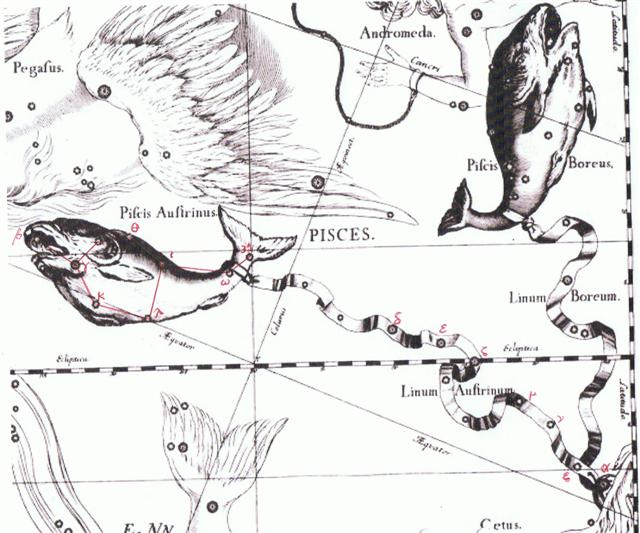Below I have redmarked also the stars in the Virgo constellation, because I guess they could be relevant for understanding the text. For instance rose in rongorongo times the first star (ω) of Virgo heliacally in the Gregorian 'π day' (March 14 = 3-14). Perhaps the pair of manu rere birds with undulating wings (as if they were shaking off water) are there in order to put focus on this number between Cb7-5 and Cb7-6:
The reversal indicated by the Sign of a manu rere bird looking towards the past (Cb7-7) - which occurs quite seldom in the rongorongo texts - could also be meant to underline the change defined by the first heliacal star (ω) of Virgo reflected by the last heliacal star (ω) of Aquarius:
Possibly Metoro knew that ω Piscium (Dzaneb) - at the 'circlet' around the tail of the southern of the pair of fishes - rose with the Sun in March 18 (443). This could have motivated his te moko tu ('stands up') - definitely a Sign for Bishop Jaussen - and perhaps meant to point at the cycle of 15 * 29½ = 442½.
540 = 1½ * 360 and Cb7-4 maybe was marking the end of the cycle which the Chinese appreciated so much (which I once read somewhere). The pair of flanking rau hei glyphs were probably intended to indicate the importance of Cb7-4. 540º is the sum of the inner corners in a pentagon. 1½ * 364 = 546 = 2 * 273, where 273 could allude to September 30 (273). 540 / 2 = 270 (September 27). The Chinese may have liked 1½ years because 273 = 260 + 13 = 21 * 13. I have heard the ordinary chickens needs 21 days before they will be able to use their egg tooth to break through.
Counting the number of degrees in a circle not as 360 but as 365¼ (which the Chinese once did) will transform 1½ years to 1½ * 365¼ = 547.875 Chinese degrees. Half that becomes 273.9375 or practically 274 such degrees. This could refer to the time of October 1 (274) = 254 (September 11) + 20. In the Hall of Two Truths there were 42 assessors and 21 * 2 = 42: ... The four bereaved and searching divinities, the two mothers and their two sons, were joined by a fifth, the moon-god Thoth (who appears sometimes in the form of an ibis-headed scribe, at other times in the form of a baboon), and together they found all of Osiris save his genital member, which had been swallowed by a fish. They tightly swathed the broken body in linen bandages, and when they performed over it the rites that thereafter were to be continued in Egypt in the ceremonial burial of kings, Isis fanned the corpse with her wings and Osiris revived, to become the rule of the dead. He now sits majestically in the underworld, in the Hall of the Two Truths, assisted by forty-two assessors, one from each of the principal districts of Egypt; and there he judges the souls of the dead. These confess before him, and when their hearts have been weighed in a balance against a feather, receive, according to their lives, the reward of virtue and the punishment of sin ...
|







